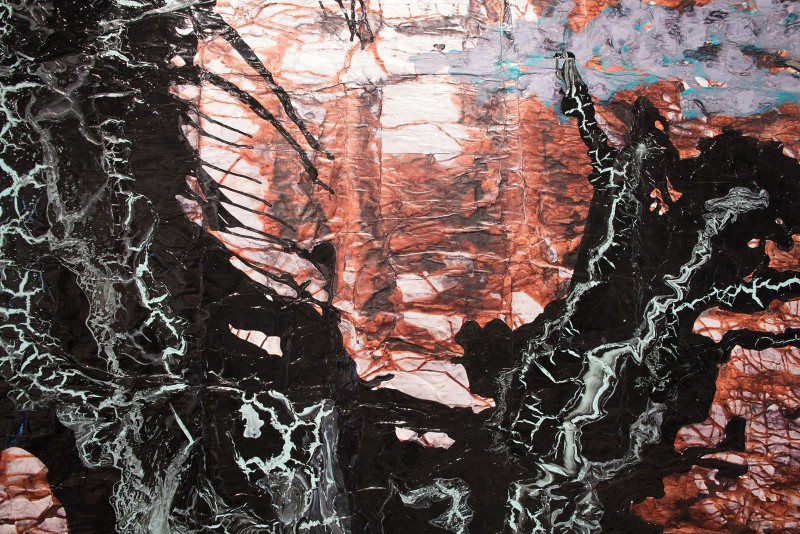
Stranger Fictions (at Rodney McMillian: The Black Show)
by Martha Swift
According to curator Anthony Elms, Rodney McMillian: The Black Show is an exhibition about transformation.
You might prefer to call it an exhibition about flux. It is about fictions, literally literary, with numerous instances of homage to Octavia Butler, and metaphorically historical, as McMillian himself expounded in a preceding interview. It is about mutable spaces, fluid identities, the distance between material and perception, the so-called experience of this ‘reality,’ and the staking out of that reality itself as a constantly undulating landscape.
The space at one moment is never the same as the space at the next, nor is your perception of it.
As all of the publicity material boasts, this exhibition features just over 45 minutes of film, staggered throughout the gallery. Change is enacted both within the frame (as shots change or new locations are discovered) but also beyond it. Your experience of the exhibition itself is forever being remediated as the films loop, moving in and out of sync with each other, providing ever-shifting backdrops. In the moments between finish and repeated start there is flux. In the minutes spent waiting for one film to realign with another, there is flux.
The very gallery is, in fact, is being continuously transformed, as is your experience of the exhibition’s own internal ‘landscape,’ if you will. The colossal “Many Moons” (2015) winds its way through the center of the whole room–or is it along one wall of the first room? Painted specifically for this exhibition, and therefore specifically for this space, the work is a fantastical metallic tree-scape 70 feet long and 14.5 feet tall. Its corrugated surface is traced in latex, acrylic, and ink on paper. Peach, rust, red, black, silver, blue branches clutch at each other under the gaze of three luminous lacquered moons. At first it is on the far wall, then the left wall, then suddenly it is just an immense divider behind which more works are hiding. As you round the corner, the room in which you stand is revealed as both real and fabricated. You begin to renegotiate the space around you, reevaluate your place in it.
It is an in-between state allowed by the prophetic script to “Preacher Man” (2015), a short single-channel video in which McMillian performs an abridged monologue by Sun Ra. ‘Death is the only god’ proclaims the disguised artist, in suit and cane, from amidst studio-light foliage. All people are subject to death; thus, life must be understood as a temporary liminal moment; between inevitable birth and inevitable death–and if this is, as you know, the artist’s intended introduction to his show, you can’t help but think that the gallery now represents a somewhat similar zone. It is a moment of mutability, possibility, meaning-production. Your act of viewing is now an exploration of that interpretive process, of the translation between material and value.
Before you watch that first short film of the show, however–before you even notice it–before, in fact, you have stepped over the threshold of the gallery, McMillian has already begun to challenge the certitude of form. Already you are being pulled into a space where conventional histories are being brought under review.
A great black flower crawls across the wall before you. No. A patchwork throat threatens to swallow it and maybe you. No? A black hole yawns its way out of its own center. You can see all of these visions–in turn, at once–but you also cannot help but see the coarse white stitches running in neat triangles or the uneven texture of the swathes of vinyl they hold together. Here it is shiny, almost viscous, there it is matte, possibly nicked; bunched, stretched, solidified. You are made to think about both the reduction of painting to its material components and its expansion well beyond them, into the social, the cultural, the metaphorical. The vinyl and thread of “Succulent” (2010), the fundamental materials of the work, come to knowingly coexist with your own act of interpretation; maybe even interpellation.
Reality is history is fiction. “Both are present tense in that our interpretation of them is through the prism of us projecting onto or gleaning information from them. […] [T]he way the histories are told, the way that we understand the nuances during the complexities of those periods, that’s the fiction.” (Zuckerman, “Painting the Domestic,” 2015) McMillian’s works are fictions, too, but, crucially, self-aware fictions.
If you want to politicize this, it is easy; perception and materiality are divergent. Somewhere on that spectrum lies reality, but it is that gap and the accompanying need to interpret physicality that has allowed the historical conflict and discrimination in the arenas of class, race, and gender, that Elms recalls in his introduction to the exhibition and that McMillian himself has proposed. As Sun Ra-made-artist-made-preacher proclaims on a six minute loop; “the only equality they get is that they all gonna die.”
Martha Swift is a graduating English and History major at the University of Melbourne, Australia. She spent six months in Philadelphia at the start of 2016 as part of an exchange program with the University of Pennsylvania.









